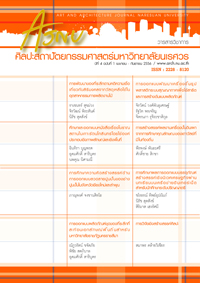การศึกษาความคิดสร้างสรรค์ด้านการออกแบบลวดลายปูนปั้นของช่างปูนปั้น ในจังหวัดเชียงใหม่และลำพูน
Main Article Content
บทคัดย่อ
การวิจัยครั้งนี้มีวัตถุประสงค์เพื่อ 1) ศึกษาและวิเคราะห์ข้อมูลเกี่ยวกับช่างปูนปั้นในจังหวัดเชียงใหม่และลำพูน 2) ศึกษากระบวนการของความคิดสร้างสรรค์ด้านการออกแบบลวดลายปูนปั้นของช่างปูนปั้น จังหวัดเชียงใหม่และลำพูน และ 3) ศึกษาอัตลักษณ์ของลวดลายปูนปั้นในจังหวัดเชียงใหม่และลำพูน ประชากรในการศึกษาคือช่างปูนปั้นในจังหวัดเชียงใหม่และ ลำพูน คัดเลือกจากช่างปูนปั้นที่อาศัยอยู่ใน 3 อำเภอคือ ดอยสะเก็ด สารภี และเมืองลำพูน ใช้วิธีคัดเลือกกลุ่มตัวอย่างแบบ เจาะจง (purposive sampling) จากช่างปูนปั้น จำนวน 30 คน เครื่องมือที่ใช้ในการเก็บรวบรวมข้อมูลเป็นแบบสัมภาษณ์แบบมี โครงสร้าง (structured interview) และแบบกึ่งมีโครงสร้าง (semi-structured interview) วิเคราะห์ข้อมูลโดยใช้วิธีการ วิเคราะห์เนื้อหา (content analysis) การตีความข้อมูล (interpretation) ผลการวิจัยพบว่า ช่างปูนปั้นในจังหวัดเชียงใหม่และ ลำพูน จำแนกเป็น 2 ประเภท ได้แก่ 1) ช่างปูนปั้นพื้นบ้าน เป็นช่างที่ไม่ผ่านการศึกษาจากสถาบันการศึกษาทางด้านศิลปะ แต่ อาศัยการเรียนรู้ด้วยตนเอง จากช่างอาวุโสและช่างที่เป็นงานแล้ว และ 2) ช่างปูนปั้นประยุกต์ เป็นช่างปูนปั้นที่ผ่านการศึกษา จากสถาบันการศึกษาทางด้านศิลปะ และช่างปูนปั้นทั้ง 2 ประเภทนี้ ส่วนใหญ่ต้องเริ่มเรียนรู้งานปูนปั้นจากการตำปูนเป็น พื้นฐาน และสามารถจำแนกเป็นกลุ่มช่างตามบริบทของพื้นที่อาศัย ได้ 4 กลุ่มคือ กลุ่มช่างดอยสะเก็ด กลุ่มช่างสารภี กลุ่มช่างแม่ วาง และกลุ่มช่างลำพูน กระบวนการของความคิดสร้างสรรค์ด้านการออกแบบลวดลายปูนปั้น สามารถแบ่งออกเป็น 5 ขั้นตอน ดังนี้คือ 1) ขั้นกำหนดความคิดเบื้องต้น ประกอบด้วยการกำหนดความคิดในกระดาษและบนพื้นผิวจริง 2) ขั้นการถ่ายทอดเป็น รูปธรรม ประกอบด้วยการเตรียมการ การปฏิบัติการ และการทำให้มีชีวิต 3) ขั้นการบูรณาการความคิด ประกอบด้วยการ ประยุกต์ใช้ และการสร้างจินตนาการ 4)ขั้นการทำให้เกิดความสมบูรณ์ ประกอบด้วยการทำให้เกิดมิติและการตกแต่งผิว และ 5) ขั้นการทำให้เกิดการยอมรับ สำหรับอัตลักษณ์ของลวดลายปูนปั้นในจังหวัดเชียงใหม่และลำพูน แบ่งเป็น 3 ลักษณะดังนี้คือ1) อัต ลักษณ์ของประเภทลวดลายปูนปั้น ได้แก่ลวดลายที่ใช้ตกแต่งศาสนสถานและไม่ใช้ตกแต่งศาสนสถาน 2) อัตลักษณ์ของขั้นตอน การปั้นลวดลาย จำแนกเป็น 2 ขั้นตอนคือขั้นตอนการเตรียมและขั้นตอนการปั้น และ 3) อัตลักษณ์ของรูปแบบลวดลายปูนปั้น จำแนกได้ 2 รูปแบบคือ ลวดลายปูนปั้นที่ไม่ตกแต่งสี และลวดลายปูนปั้นที่ตกแต่งสี
A Study of the Creativity of Stucco Patterns Design by Artisans in Chiang Mai and Lamphun
This research aims to 1) study and analyze the information on artisans in Chiang Mai and Lamphun 2) study about the process of creativity in stucco patterns design by artisans in Chiang Mai and Lamphun and 3) study the indentity of stucco patterns in Chiang Mai and Lamphun. The population studies of this research are artisans selected from Chiang Mai and Lamphun living in 3 districts which are Doi Saket, Sarapee and Muang Lamphun. The selection is by Purposive Sampling of 30 artisans. The research instruments used in the data collection are structured interview and semi-structured interview. The information is analyzed by using content analysis and interpretation.The results show that artisans in Chiang Mai and Lamphun are divided into 2 groups which are 1) local artisans who did not study in art institutes but acquired the skills from self-learning, older artisans and skilled full artisans 2) applied artisans who graduated from art institutes. In the beginning, both groups of artisans have to start from the basics of learning how to pound plaster. The artisans can be divided into 4 groups according to their residence which are Doi Saket artisans, Sarapee artisans, Mae Wang artisans and Lamphun artisans. There are 5 stages to the process of creativity of stucco patterns design which are 1) establishing the primary idea by settling the ideas on paper and on real surface 2) transferring them on to concrete objects by preparing, operating and bringing work to life 3) integrating ideas by applying and using imagination 4) perfecting the work by adding dimensions and decorating the surface and 5) making the public accept the work.The indentity of stucco patterns in Chiang Mai and Lamphun are separated into 3 types. There are 1) the indentity of stucco patterns are patterns used in religious places and patterns that are not 2) the indentity of stucco which are the preparing stage and the molding stage and 3) the indentity of the stucco patterns can be divided into 2 types which are patterns without color decorations and colorful decorated patterns.


